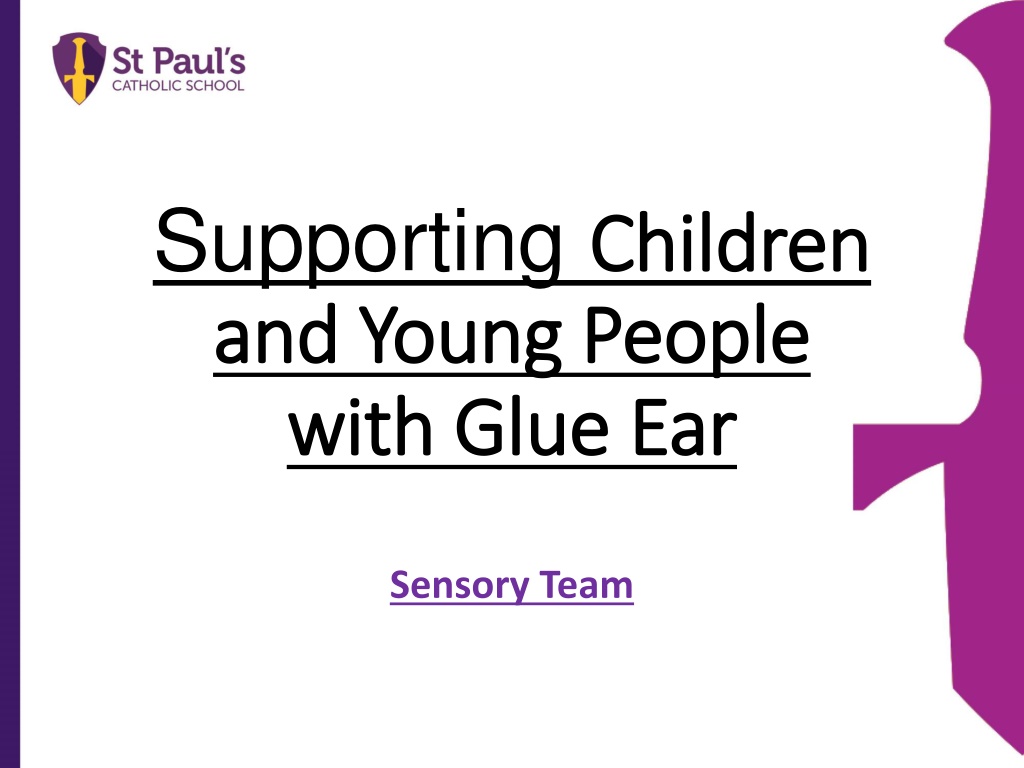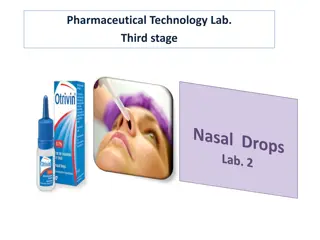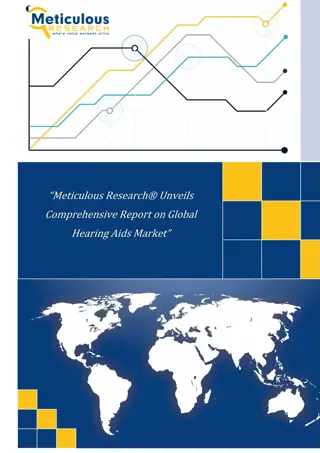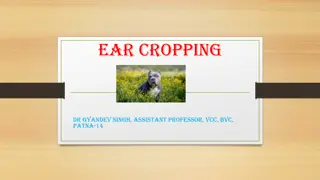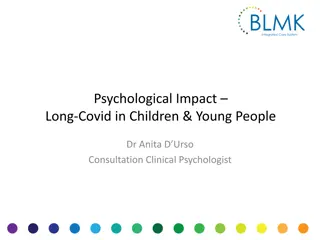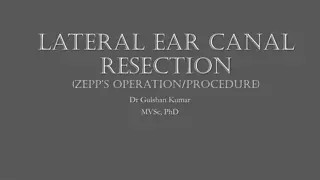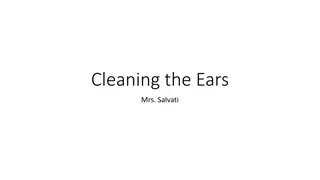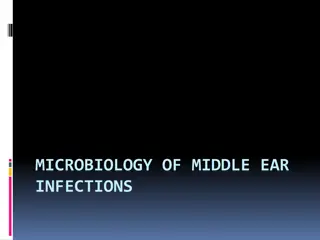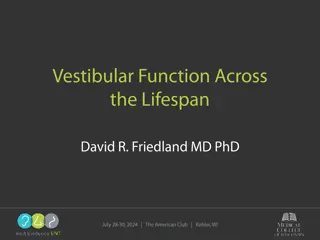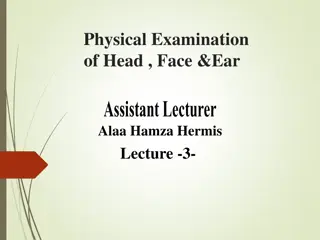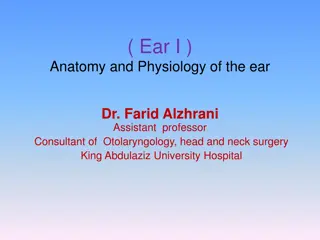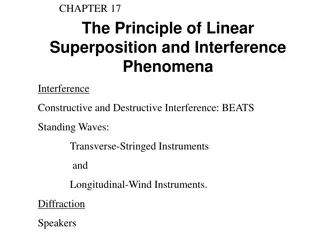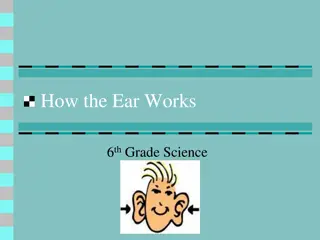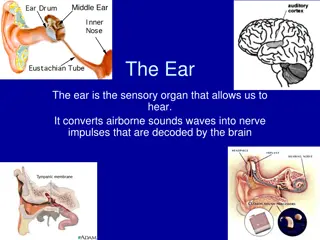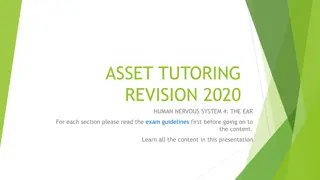Understanding Glue Ear in Children and Young People
Glue ear is a condition where the middle ear fills up with fluid, causing temporary hearing loss. It is important to be aware of the signs of glue ear, such as speaking loudly, asking for repetition, and finding it hard to concentrate. The impact of glue ear can affect physical comfort, balance, speech and language development, and social-emotional well-being. Seeking medical advice, such as from a GP or school nurse, is crucial for proper management, which may include a watch-and-wait approach or referrals for further evaluation and treatment.
Download Presentation

Please find below an Image/Link to download the presentation.
The content on the website is provided AS IS for your information and personal use only. It may not be sold, licensed, or shared on other websites without obtaining consent from the author. Download presentation by click this link. If you encounter any issues during the download, it is possible that the publisher has removed the file from their server.
E N D
Presentation Transcript
Supporting Children and Young People and Young People with Glue Ear with Glue Ear Children Sensory Team
What Is Glue Ear? Glue ear is where the middle part of the ear canal fills up with fluid. This can cause temporary hearing loss. Glue ear is usually a temporary and fluctuating condition which usually clears up on its own, but parent/carers are advised to see a GP.
What Is Glue Ear? https://www.nhs.uk/Video/Pages/Glueearanimation. aspx Please watch the video at the bottom of this link as it explains in detail what glue ear is, what causes it and how it's treated The middle ear is filled with fluid rather than air
Signs Of Glue Ear There may be many signs of Glue Ear, these may include: speaking loudly being difficult to understand asking people to repeat what they say asking for the TV or music to be turned up loud struggling to hear people far away becoming easily distracted when people are talking finding it hard to concentrate or seeming tired and irritable because it's harder for them to listen not engaging / distant in activities/tasks/group discussions copying peers watching speaker intently finds loud sounds disturbing
Impact Of Glue Ear Glue ear may result in the following: Cause physical symptoms one or both ears may feel uncomfortable / sore, may affect balance Affect listening Affect speech and language development Affect social and emotional development Be aware Glue Ear can fluctuate. Check in particular, the child who has a cold or seems distracted. Say their name and smile.
What to do? With parental consent, refer to the School Nurse or GP/HV for referral Ask family to take child to GP or Health visitor GP/Health Visitor may suggest a watch and wait for 3 months Exceptions for quick referral: smelly ear, children in higher risk groups eg Downs Syndrome or a cleft palate. Family may request referral to Paediatric Audiology through GP Management options - ENT referral for consideration of grommets or hearing aids .
What To Do Whilst Waiting? Adapting the environment Adapting your communication Providing activities to support: - Listening - Language - Social and emotional development
Adapting The Environment Be aware of poor acoustics and their impact: Reduce background noise where possible; for example use table coverings, carpets and soft furnishings to reduce reverberation reduce extraneous noise; close doors/windows to outside areas whilst noisy activities are happening outside; choose when you have music playing not constantly in the background Use visual aids and props to maintain focus and use supporting vocabulary Be aware of light source in class Use favourable seating (front and facing speaker)
Adapting Your Communication Establish listening rules Get the child s attention before you start speaking by using their name Make sure the child can see your face, make eye contact and smile Speak clearly, with normal intonation and rhythm - don t shout Start with simple language relating to what they are doing Use short sentences or chunks of language that are supported with pictures or objects Begin with what they have said and expand on it. Repeat when necessary If using more complex language always give examples and context to support understanding Check understanding using open-ended questions
Providing Activities To Support: Listening, Language and Social and Emotional Development Listening: - use of games which require a pupil to follow instructions, for example, barrier games - check using open-ended questions Language: - use multi-sensory activities and visual aids to support language - Build on what the child says and add information Social and Emotional Development: - Organise, monitor and manage group activities - Support and model checking methods so the child can inform others when they haven t heard some thing - provide visual aids to explain their emotions
Further Information Further information and resources can be found: www.ndcs.org.uk/information-and-support/childhood- deafness/causes-of-deafness/glue- ear/?gclid=CjwKCAiA3aeqBhBzEiwAxFiOBqxz6DeKOtChlXhZB yXl9g- B1Pgmb2C8UUV3fJavLG46XoTX3mDn2hoCzOEQAvD_BwE# Free National Deaf Children s Society (NDCS) training course for professionals www.ndcs.org.uk/our-services/services-for- professionals/training-courses/e-learning/introduction-to- temporary-hearing-loss-cpd-accredited/ www.GlueEarTogether.org.uk - Free resource Hearing to Succeed and Achieve
Further Information https://youtu.be/56agaiGhAuw
Treatment For Glue Ear Treatment for glue ear is considered by a GP Glue ear is not always treated. The GP may wait to see if the symptoms get better on their own. This is because there's no effective medicine for glue ear, and it often clears up on its own. The child may be monitored for up to a year in case their symptoms change or get worse. The GP may suggest trying a treatment called autoinflation while waiting for symptoms to improve. Autoinflation can help fluid in the ear to drain. Discuss autoinflation with GP/HV/School Nurse The 2 main treatments are grommets (small tubes implanted in the ear) or temporary hearing aids. Occasionally, surgery may be recommended to remove some glands at the back of the nose (adenoids). This is known as an adenoidectomy. The specialist in hospital will decide on the best treatment option.
Some Useful Terms Grommets Grommets are small plastic tubes which sit in a hole in the eardrum, and let air get in and out of the ear. Grommets are sometimes also called ventilation tubes. Hearing loss Normal hearing is when the quietest sound a person can hear in either ear is anywhere between 0 dB to 20 dB. Hearing loss is defined as when a person cannot hear sounds until they are above that 20 dB threshold in one or both ears. The louder a sound needs to be in dB before they can hear it, the greater their level of hearing loss (for example, someone who can only hear sounds of 50 dB or more has greater hearing loss than someone who can hear sounds of 25 dB or more). Hearing tests This can be any suitable test to assess hearing, but should always be age and developmentally appropriate for the person, and use properly calibrated equipment.
Need Further Information Contact Details Uday Thakrar (Head of Sensory Team) Uday.Thakrar@Milton-Keynes.Gov.UK Tel: 01908 669735 ext 147
